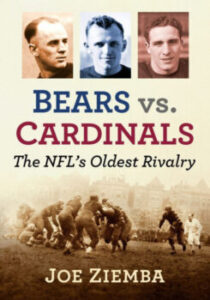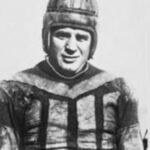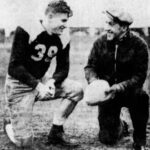a trio of players from the Chicago Bears that you may have never heard about. After all, they played nearly a century ago and except for one, never received much public–or lasting-acclaim. Throughout the years, the National Football League has seen its share of rogues, complainers, whiners, and personality problems among its players…but we’ll just call these guys “characters”!
Each brought something different to the Bears and all were valuable in their own distinct way, but all were under the watchful eye of none other than team owner and coach George Halas. Ironically, all three were on the field for the Bears during one of the most groundbreaking games ever played in the NFL…and all three were comfortable on the gridiron, as well as in the ring.
John Doehring: He Can Pass the Football 100 Yards!
We’ll start with a left-handed halfback named John “Bull” Doehring who was born on November 6, 1909. Bull attended West Division High School in Milwaukee before heading west to attend Santa Ana College in California. Things did not work out well there for Doehring as the Santa Ana Register later reported:
“Big John never cracked a book all the time he was here, and he was a hopeless flunkout at the end of his term, failing to make a single credit.” After stints at the Kentucky Military Institute and the Illinois Military Institute, Doehring was expected to enroll as a sophomore at the University of Wisconsin in 1932. However, the Capital Times reported that “Doehring was rated as one of the best prep gridders ever turned out in Wisconsin, but it was learned that he had failed to pass entrance examinations.” And so, Doehring wandered down to Chicago where Bears Coach George Halas signed the big 212 lb. halfback on November 11, 1932.
In those days, the halfback did a great deal of the passing on offense, and that was what impressed Halas. Doehring could throw the ball very far…extremely far…and with accuracy! How far? The San Francisco Examiner once wrote about the Bears and Doehring: “They had, in their ranks, the greatest left-handed passer in the game, John Doehring, who can throw a football 80 yards.” But throwing a forward pass was not Doehring’s only talent, according to the Los Angeles Daily News which said: “The Bears boast a halfback named John Doehring who can pass the porker 100 yards. And he is the only gridder in the world who can toss ‘em from behind his back for 60 yards!”
Of course, we wanted to find out if any of these tall tales were true. Could someone accurately throw a football 60 yards behind his back? In the book, What A Game They Played, author Richard Whittingham shared a story about Doehring from Luke Johnsos, an end for the Bears in the 1930s:
Bull took a lateral and started out towards the sidelines. He was supposed to throw a long pass to me, but he was in trouble, the defense was all over him. He didn’t even have room to raise his arm. I looked away, figuring the play had failed. Then I happened to look up and there, coming straight into my hands, was the ball. I was so surprised I dropped it! As we were walking to the dressing room later, I asked him how he got rid of the ball. ”Well, they were rushing me so I threw it behind my back.” And that’s what he had done, thrown the ball behind his back. Forty yards. Right into my hands.”
Author Howard Roberts added to the legend in his book called The Chicago Bears when he stated: “Doehring never threw the ball in a game as far as he could for the obvious reason that no one had time to run far enough down the field to catch it.
In practice one day the Bears swear he sent a football careening through the air from one goal line to the opposite ten-yard line—a ninety-yard pass.” Unfortunately, while Bull lasted six seasons in the NFL, including one with Pittsburgh, his career numbers of 627 passing yards and seven touchdowns reflected that he was rarely on the field for the Bears. But George Halas felt that he was valuable and even put up with some memorable experiences with Bull. Once, Halas noticed that Bull missed an evening team meeting so Halas asked him where he was when they met the next day. Bull responded by saying. “George, you say the same things over and over, so I just went to the movies.”
Doehring’s NFL career ended after the 1937 season and a barnstorming tour in early 1938, but he also wrestled professionally and played minor league baseball as a pitcher. In 1938, he caught the eye of manager Bill McKechie of the Cincinnati Reds who said: “I don’t know when I saw a faster ball. I wouldn’t believe my eyes until I asked catcher Virgil Davis and he said I was dead right. Honest, I believe he’s the finest prospect in all my experience.” Maybe Bull failed to show up for a team meeting, but it appears that he never made a major league roster, yet continued to toil for semi-pro teams in Wisconsin. Next up, we have a big man to discuss. A really big man!
Nothing Small About Shorty Burdick!
There was nothing small about Lloyd “Shorty” Burdick. Not his size, his appetite, his personality, nor his gifted athletic ability. Burdick, born August 8, 1908, graduated from powerful Morgan Park Military Academy in Chicago after a standout career in football and basketball.
For the 1920s, he was a huge lineman going about 6’5” and 230 pounds, landing Burdick the affectionate nickname of “Shorty.” His outstanding play on the gridiron was just the first stop in a jam-packed athletic career that would take Shorty to acclaim on the gridiron for the national champion University of Illinois and later with the NFL titlist Chicago Bears.
But there’s more…Burdick was also a boxer, a pro wrestler, a musician, a track star, an actor, and a real-life hero who once saved two children from near death.
Once in high school, his coach decided to move Burdick to the backfield in the second half of a game played at Cubs Park. Burdick scored immediately on a 70-yard scoring run early in the second half. The Southtown Economist reported: “Burdick started on a rampage as soon as the second half was underway by running through the entire Latin team for a touchdown. Burdick, with one more run of seventy yards and another of forty-five, added twelve [more] points to the score.” Burdick’s rushing efforts in the third quarter alone resulted in 185 yards gained on just three carries.
Burdick was a dependable varsity tackle for Coach Zuppke at Illinois, including during the 1927 season when the Illini finished 7-0-1 and was declared national champion. Shorty concluded his football career at Illinois with a 6-1-1 mark in 1929, leaving Burdick’s teams with an impressive three-year record of 20-2-2. By Burdick’s senior year, he was becoming as widely known as a wrestler as he was a football player. His reputation on the wrestling mat was solidified in 1930 when Burdick was the Big Ten heavyweight champion and finished in second place in the National Collegiate Association wrestling tournament at Penn State.
Bears Win 1932 Title
In 1931, Burdick signed with the Chicago Bears and soon earned a starting tackle spot. Once again, Burdick was positioned to be an integral part of a special team. In 1932, the Bears concluded their schedule with a wacky 6-1-6 mark and defeated the Portsmouth Spartans for the NFL title in a “playoff” game played indoors at Chicago Stadium.
During the 1932 season, Burdick would receive high praise from his teammate Red Grange. In an article in the Saturday Evening Post, Grange showed his respect for Burdick by marveling: “Picture a fast, trimly built athlete…then imagine Jack Dempsey [heavyweight boxing champion] two or three inches taller and fifty pounds heavier, and you have Lloyd Burdick.”
Like Dempsey, Burdick also decided to try boxing. Shorty knocked out 18 straight opponents and fought to one draw in his brief pugilistic career, before explaining why he decided to stick with wrestling as his main sport outside of football: “I just got tired of having a headache every time an opponent tapped me on the jaw and decided it was made of glass. As I desired to engage in some combative sport, I turned to wrestling. I’m not sorry, either.”
If that wasn’t enough, the big lineman was even selected to play the role of “Pilate” in a Passion Play that was produced in Chicago for the 1933 World’s Fair with a cast of 300.
To get a good feel of what it looked like back in 1933, you can watch the film of the World Fair below.
After starting for the Bears for two campaigns in 1933, Burdick found himself as a member of the Cincinnati Reds of the NFL, which was actually a new franchise. Burdick played only the 1933 schedule for the Reds where he quickly claimed the starting right tackle spot. On December 27, 1933, Cincinnati announced a blockbuster trade involving Burdick with the Portsmouth Spartans which sent Burdick to Portsmouth for four players, a bit unusual for the time. Instead, Shorty decided to end his football-playing career.
Maybe the only thing “short” about Lloyd “Shorty” Burdick was the amount of time he spent on this earth. He lost his life in 1945 in an unfortunate train accident at the age of 37. He was a winner at all levels from his undefeated team at Morgan Park Military Academy to his national championship at
Illinois, to his NFL title with the Chicago Bears. Ultimately, Burdick will be remembered for his big accomplishments, his large stature, and his huge personality…
George Trafton Never Lost A Barfight
The final name on our list is more of a familiar one: lineman George Trafton. Trafton was a member of the Staleys/Bears from 1920-1932, missing just the 1922 season to coach at Northwestern, after playing for Notre Dame. He was a six-time All-Pro, a member of the All-Decade team of the 1920s and was elected to the Pro Football Hall of Fame in 1964.
Perhaps all we need to know about Trafton is his nickname: “The Beast.” In our discussion today, we’ll follow that “wild” side of Trafton which was evident both on and off the field. In an earlier episode of When Football Was Football, which can still be accessed on the Sports History Network, we discussed the “NFL’s First Grudge Match” between the Staleys and Rock Island in 1920 where Trafton played a key role.
Trafton was considered such a villain by the Rock Island fans that Halas made plans for his star center to exit the field early during a scoreless tie and to take the Staleys’ portion of the game receipts with him. Halas was asked: “Why did you do that?” He replied: “Because I would be running only for the money; Trafton would be running for his life.” And that sets the stage for our Trafton discussion.
Machine Gun McGurn Walked In
Trafton claimed to be good with his fists, both on and off the field. Once he was suspended by Halas for taking on a late-night intruder who was sitting on his car. Halas didn’t mind the fight, but since the altercation took place in the wee hours of the morning according to police reports, Trafton was breaking training rules. Anyway, Trafton loved the night life in Chicago and was never reluctant to pursue any drunken bar room challenges.
At this point, we’re going to call on the great Red Grange to describe the short-lived pugilistic career of his teammate, George Trafton, which began in 1929 with a bout scheduled with husky Art Shires of the Chicago White Sox baseball team. Grange recalled the events in an interview with the Chicago Tribune in 1968:
“I actually helped promote it,” Grange said. “On this night we were helping Trafton celebrate his birthday. He had never lost a fight in a night club. After midnight, someone brought in a copy of the Chicago Tribune. Its big sports story announced that Art Shires, then trying to make some extra bucks in the ring to carry him through the winter, had signed to fight some chump. ‘I can beat him with one hand,’ Trafton snorted. Why not we thought.”
“My brother Garland was in the party and he was a neighbor of Jim Mullen, who was promoting the Shires’ bouts. So, along about 2 am he called up Mullen. ‘Great,’ Mullen said, ‘we’ll sign the contracts tomorrow.’ Next day, we’d forgotten all about it, but not Mullen. And Trafton suddenly remembered when he was offered a $1,000 guarantee for three rounds. A few days later, when Trafton was going through the motions of training, a couple of harsh looking characters walked into the gym. ‘Who’s going to win?” one of them asked. ‘Trafton,’ one of our group replied. ‘He’d better not,’ one of them growled.
A day or two later, a slick young fellow walked in and asked the same question. My brother replied: ‘Up until yesterday, we thought Trafton was’ and then told him about the visitors the day before. ‘Forget ‘em,’ the guy told us. ‘They’ll never bother you again. I’ll take care of them. All I want to know is the fight on the up and up. If it is, I’ll bet on Trafton.’ We learned later who the young man was: it was Machine Gun Jack McGurn [one of Al Capone’s leading henchmen].”
By the way, Trafton did end up winning that battle with Shires, which some called the “Laugh of the Century.” But the bout did attract 5,000 spectators, including it was rumored, Al Capone himself. Trafton continued boxing until making the mistake of fighting talented heavyweight prospect Primo Carnera on March 26, 1930. Trafton lasted less than a minute.
This was the middle of three first round knockouts that Carnera won in an eight-day span in March of 1930. Eventually, he became the world’s heavyweight champion while Trafton wisely returned to playing pro football. And by the way, all three of our featured players were all members of the NFL champion Chicago Bears in 1932 when the NFL crown was captured during the first NFL game played indoors.
We thank you for reading this post of When Football Was Football on the Sports History Network. If you wish to hear the entire post in a podcast form, you can do so below.
Please join us next time for a review of the NFL’s first-ever draft which was held in 1936 and we’ll examine why the first player picked never played pro football. Or did he?
Joe Ziemba is the host of this show, and he is an author of early football history in the city of Chicago.
Here, you can learn more about Joe and When Football Was Football, including all of the episodes of the podcast.
Please Note – As an Amazon Associate I earn from qualifying purchases
Resources
More From When Football Was Football
Paddy Driscoll’s Almost Perfect Season
Back at the beginning of the National Football League in...
Read More120,000 Fans Witness High School Football Game in 1937!!!
Let’s set the stage… It was a warm November afternoon...
Read MoreIn The Beginning: An Interview With Joseph T. Sternaman
And, you may ask, who is Joseph T. Sternaman? Sternaman...
Read More1948: The Last Hurrah of the Chicago Cardinals
Cardinals’ fans are familiar with the long, sad story concerning...
Read More




